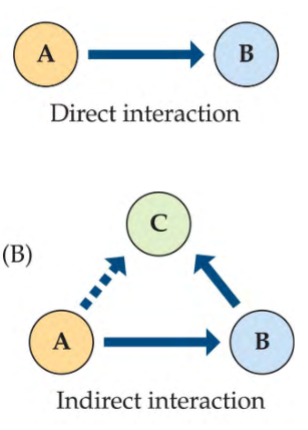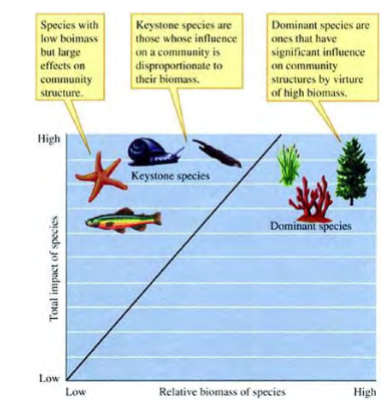Ecology - Mod 13 (Ch 16): Communities
1/30
Earn XP
Description and Tags
Name | Mastery | Learn | Test | Matching | Spaced |
|---|
No study sessions yet.
31 Terms
population
a group of individuals of a single spp that live in a particular area at the same point in time
occur in communities
community
populations of different spp living and potentially interacting in a certain area at a given time
interactions between spp that shape communities
predation (+/-)
commensalism (+/neutral)
parasitism (+/-)
mutualism (+/+)
competition (-/-)
how biological communities are often differentiated
based on physical or biological characteristics
biological communities defined based on physical characteristics
physical attributes = abiotic characteristics (climate, H2O characteristics, soil type, location, other habitat features)
similar types of characters used to define biomes
abiotic factors (e.g. temp, precipitation, substrate type) determine which spp occur in a community
only those spp with the necessary adaptations for survival and reproduction under the particular abiotic conditions can occur
e.g. all the spp that occur in a: desert, stream, pond, cave, tropical rainforest
biological communities defined based on biological characteristics
biological = biotic
implies the importance of particular abundant spp
e.g. kelp forest community, longleaf pine community, coral reef community
subset of a spp in community
what most ecologists study in a community
(too many spp to study simultaneously, too difficult)
may be selected based on taxonomic similarity, guild, functional group
taxonomic similarity
related due to similar evolutionary lineages
e.g. bird community, insect community, fungal , algal community
guild
a group of spp that use the same resources even though they may be taxonomically unrelated
e.g. nectivore , plankton , piscivore community
functional group
a group of spp that function in similar ways but may or may not use the same resources
e.g. piercing mouthpart community, aquatic photosynthesizers, nitrogen-fixing plant community, predator community, decomposer community, pollinator community
what a community ecologist may study
which organisms occur in a community (community structure)
interactions among organisms in a community (e.g. food chains and webs)
how interactions affect community composition
2 aspects of community structure
spp diversity
spp composition
spp diversity
combines spp richness and evenness into a single index which allows comparison of communities
spp richness
the # of spp in an area
spp evenness
the relative abundance of spp in an area
Shannon-Wiener index
a diversity index allowing comparison of diversity between 2 or more communities
pi = proportion of each spp
higher H value indicates higher spp diversity

spp accumulation curves
spp richness plotted as a function of total # of individuals counted
help determine when all of the spp in a community have been observed
when additional sampling effort no longer results in new spp, likely near total # of spp in the community

factors affecting how many spp will be observed when sampling a community
# of individuals sampled (more individuals sampled = more spp observed)
area sampled (more area sampled = more spp observed)
heterogeneity of area sampled (more homogeneity of area = more spp observed)
proportion of rare spp in sample area (more rare spp in area= fewer spp observed)
spp composition
identity of spp in a community
which spp occur in a community determines the types of interactions
trophic structure
feeding relationships among organisms
i.e. how the organisms in a community obtain energy
determines the pattern of energy movement through an ecosystem
can be illustrated with food chains or webs
2 ways to consider trophic structure
food chains: distinguish trophic levels with one chain (1 path through a food web)
trophic level = groups of spp that have similar ways of obtaining energy
food webs: show links between food chains
difference between food webs and interaction webs
interactions include both trophic and non-trophic interactions, e.g. competition and mutualism
direct and indirect interactions
direct interactions: include both trophic (i.e. predation) and non-trophic (e.g. competition) interactions
indirect interactions: relationship between 2 spp is mediated by a third (or more) spp. Affect population growth rates (i.e. survival probability or reproductive rate)
types of indirect interactions: trophic cascade, trophic facilitation

trophic cascade
rate of consumption at one trophic level results in a change in spp abundance or composition at lower trophic levels
e.g. otters; decreased urchin consumption indirectly lowered kelp abundance, increased urchin consumption indirectly increased kelp abundance
trophic facilitation
when a consumer is indirectly helped by a positive interaction between its prey and another spp
e.g. aphids, Iva, and Juncus
aphids eat Iva. Juncus allows Iva to grow (shades soil surface, decreases evaporation and slat buildup; oxygen from Juncus roots moves into soil and gets used by Iva)
Juncus indirectly helps aphids by helping its food source grow
interaction strength
magnitude of the effect of one spp on the abundance of another spp
= C/E
C = # of target individuals with interactor present
E = #o of target individuals with interactor absent
generally measured by removing interactor spp from the community and observing the effect on the target spp
may depend on environmental factors (e.g. sea stars preying on mussels, interaction strength was higher in protected areas; sea stars were less efficient predators in waves)
per capita interaction strength
how spp interactions vary in direction
effect each individual interactor has on each target spp individual
effect density of interactor on target spp population
= ln(C/E)I
I = # of interactor individuals (capital i, not lowercase L)
important spp in community
dominant spp
keystone spp

dominant spp
most abundant or have highest biomass
some are ecosystem engineers: create, modify, or maintain physical habitat for themselves and other spp
e.g. large trees, coral
keystone spp
a spp that exerts strong community control by its ecological role (not by its abundance)
elimination dramatically affects survival of many other spp
e.g. otters, Pisaster
a spp can be a keystone spp in some communities but not in others
examples of spp that are both keystone spp and ecosystem engineers
beavers (dams create marshes with wetland plants, which increase regional biodiversity)
gopher tortoises (burrows are used by >400 spp for habitat and protection, enhance plant growth by loosening soil and redistributing soil nutrients, dung provides nutrients, food, and habitat for spp and seed dispersal)